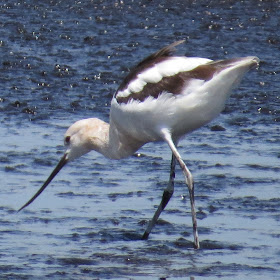Tuesday, August 4th
The month of August is a good
time to investigate the fields, farms and flooded lands of what
is described as the
Everglades Agricultural Area, in western Palm Beach County.
Bill Pranty in his
'A Birders Guide to
Florida' (2005) tells us that
these flooded fields attract thousands of
wading birds, migrating shorebirds and
larids. Coveted rare species include uplands sandpiper, buff-breasted
sandpiper and Wilson's phalarope. The uplands and buff-breasted sandpipers
should appear latter in the month on the sod farms. Today we hoping to find the
phalaropes.
 |
| American White Pelicans |
These flooded cane fields were our destination
today, as
Bob Pelkey and I were in search of these seasonal birds.
Our first stop of the day was a visit to the
'cypress stand' along the
Miami Canal
at its junction of SR-827, at sunrise. The cypress stand is a noted spot for
barn owls and I've seen some here in the past. But not today. We did see
several
Barn Swallows, a couple of
Bank Swallows, Meadowlarks, Red-winged
Blackbirds, Tricolored Herons and a calling
Bobwhite.
Along CR-827 and the bordering
Bolles Canal we had calling King Rail,
Green Herons, A Purple Gallinule,
Common Gallinule, Common Yellow-Throats, more Bank and Barn Swallows, Killdeer, a Limpkin and a very large Bobcat.
 |
| Bobcat seen in the cane fields |
 |
| Purple Gallinule along the Bolles Canal |
Along US-27 we found a large
flooded areas featuring
Black and
Gull-billed Terns, Black-necked Stilts and American White Pelicans. We also
found a
Caspian Tern, Solitary
Sandpiper, Pectoral Sandpipers, Least Sandpiper, Semipalmated Plover and
Black-bellied Whistling Ducks.
 |
| Solitary Sandpiper |
 |
| Black Tern |
 |
| Black Tern |
 |
| Green Heron |
The nearby King Ranch Sod Farm
had a few
Least and Greater Yellowlegs, more
Black-necked Stilts, Pectoral Sandpipers
and
Least Sandpipers.
 |
| Greater Yellowlegs |
 |
The Purple Swamphen has just been renamed the Gray-headed Swamphen,
to more accurately describe the particular purple swamphen species seen in south Florida
|
 |
| Black-necked Stilt |
 |
| Pair of Black Terns |
 |
| Black Tern |
 |
| Roseate Spoonbill |
 |
| Common Nighthawk |
Along CR-880, just before
reaching Brown's
Farm Road
were a dozen or so
Cliff Swallows lining
the telephone lines. Further up at the 6-Mile
Bend
Sod Farm we scanned for any grass peeps, only finding a lone
Killdeer and single
Sandhill Crane.
Our final, and very fruitful stop
was a series, of what appeared to be, formerly flooded, but now muddy and wet
fields along Brown's
Farm Road.
It had to have been this location that two days ago, a pair of
Wilson's
phalaropes were reported. We did not find any but there were thousands of birds
present. Waders were here in huge numbers including
Wood Storks, Roseate Spoonbills, Great Egrets, Snowy Egrets, White
Ibis, Glossy Ibis, Tricolored Herons, Green Herons, Cattle Egrets, Great Blue
Herons and Black-crowned Night-herons. Migrating shorebirds included
Least and Western Sandpipers, Pectoral
Sandpipers, Greater and Lesser Yellowlegs, Long-billed Dowitchers, Spotted
Sandpiper, Solitary Sandpiper, American Avocets and hundreds of
Black-necked Stilts, many with young
of various stages of growth.
 |
| Wood Storks |
 |
| Glossy Ibis |
 |
| Pectoral Sandpiper |
 |
| American Avocet with Black-necked Stilt |
 |
| American Avocets |
 |
| American Avocet |
 |
| Black-crowned Night-heron |
Others sightings here included Mottled
Ducks, American White Pelicans, Bald
Eagle, Common Nighthawk, a Black Skimmer, Black Terns, Gull-billed Terns, Barn
Swallows, Brown-headed Cowbirds, Red-winged Blackbirds and Boat-tailed Grackles.























This was a very memorable trip, Tom. At appropriate times, the EAA is a boon for wildlife observation. I enjoyed your report. Great documentation. Very much looking forward to the next trip.
ReplyDelete